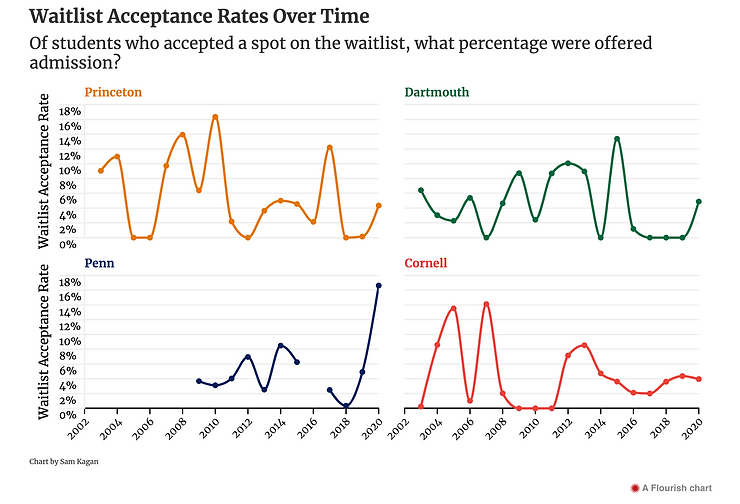Adrianne is a college admissions consultant and TV/film director, producer, writer, and actress currently based in LA. She uses her experience in multiple disciplines to help students achieve their personal and academic goals.
Recently, applicants to all of the eight Ivy League schools found out whether they were accepted, waitlisted, or rejected. Now that most of them have released their admissions data, we can deduce some trends in elite college admissions that will be helpful for students and families applying in the future to consider.

Last week, thousands of students across the world finally received their admissions decision from the eight Ivy League schools. On March 31st, or “Ivy Day,” as it is colloquially known, each applicant finally received one of three answers from their schools of choice: accepted, waitlisted, or rejected. And the data that some of the schools released can help future applicants understand the trends in college admissions that they should heed while working on their own applications.
COVID-19 made a significant difference in the college admissions landscape — from many schools going test-optional to more students deferring or reconsidering college altogether, the pandemic has ushered in several trends that are more than likely to stay. However, as cases decline and life slowly returns to normal, we’re now seeing new trends arise that will probably continue in the coming years.
Below is the college admissions data for the 2021-2022 college admissions cycle looks like at the Ivy League schools. For the first time, some of the Ivies did not release specific acceptance rates and other admissions data amidst growing criticism of the college admissions process and accessibility, especially at elite schools.
Harvard University
Number of applicants: 61,220
Growth of applicant pool: 7% increase since last year
Acceptance rate: 3.19%
Yale University
Number of applicants: 50,015
Growth of applicant pool: 7% increase since last year
Acceptance rate: 4.46%
Princeton University
Did not release admissions data for 2021-2022
Will publish enrollment data later in 2022 as part of the Common Data Set
Brown University
Number of applicants: 50,649
Growth of applicant pool: 9% increase since last year
Acceptance rate: 5%
Columbia University
Number of applicants: 60,377
Growth of applicant pool: About the same
Acceptance rate: 3.73%
University of Pennsylvania
Number of applicants: 55,000 (approx.)
Growth of applicant pool: 15,000 more than two years ago
Acceptance rate: Did not release
Cornell University
Did not release admission data for 2021-2022
Dartmouth College
Number of applicants: 28,336
Growth of applicant pool: 33% increase since last year
Acceptance rate: 6.27%
Given the data and changes from previous years, here are some of our main takeaways from the Ivy League admissions cycle of 2021-2022 for students and families.
More Applicants
Almost every Ivy League saw a substantial increase in the number of applicants this year. This trend had already been established pre-COVID, but it was only exacerbated by the pandemic and the increasing accessibility of online applications and admissions resources. More students are also applying to more schools — usually about 10-15 for each student — and many apply to at least 1 Ivy as a “reach.” While there has been a decrease in the number of students enrolling in college nationwide, at top schools, it seems like it will only continue to get more competitive every year.
This is why it’s important for applicants to distinguish themselves in a unique and memorable way through essays and extracurriculars. Early on in high school, students should consider what makes them different.
Need help with starting a project or identifying your passions? Talk to one of our experienced admissions counselors to develop a roadmap plan to help you increase your chances of admission.
Waitlists Are Getting Longer
More students got waitlisted this year at Ivies and at schools across the country than ever before. Getting waitlisted means that you’re still in the running for a spot at the school should they open up, but at Ivies, your chances of getting accepted off the waitlist are slim. However, there isn’t necessarily a way to predict how many students will be accepted off of a waitlist at a given school, and some years, no students will be accepted from a school’s waitlist. This analysis of waitlist acceptance rates at Princeton, Dartmouth, Penn, and Cornell in The Daily Princetonian shows just how random this data can be.

Credit: The Daily Princetonian
Still, if more students are taking gap years and deferring admission to college because of COVID — which they have thus far — this might lead to sustained growth in the waitlist acceptance rates. If you’re waitlisted and interested in improving your chances of acceptance, check out this post about how to get off the college waitlist.
Applying Early Still Helps
The number of students who are applying via Early Action or Early Decision also continues to increase every year, but elite schools are still more likely to accept a large portion of their applicants from their early applicant pools relative to the Regular Decision acceptances.
For instance, this year, at Dartmouth, 560 students were admitted during Early Decision whereas 1,207 students were admitted during the Regular Decision process — in proportion to the applicant pool sizes, the acceptance rate for their ED pool is much higher. Granted, that is due to myriad factors, like athletic recruitment, but if your top choice does have an Early Action/Decision option, it’s a great idea to consider applying as early as you can if your application is ready to go and, in the case of Early Decision, you’re willing to commit to attending if accepted.
More International Students
Colleges and universities are actively seeking out a diverse student body, and at Ivies, this includes intentionally admitting more international students. At Yale, the student body is now comprised of at least 20% international students, which can be largely attributed to target efforts to get more international students to apply. The increase in applications can also be attributed to this influx of international interest in attending Ivy Leagues over the years.
International enrollment in schools nationwide fell significantly during the pandemic, partly due to panic about border closings and complications that would arise because of COVID, so many schools have made a concentrated effort to help these numbers recover. International students often don’t qualify for the same financial aid as U.S. students and thus pay full price, so there is a financial incentive for colleges to have that international diversity. So if you’re an international student who is interested in attending an Ivy League school, there is no better time to apply, especially if your country is severely underrepresented at the school.
Need help with your Ivy League college application? Talk to one of our experienced college admissions consultants to help your application stand out from the crowd.



